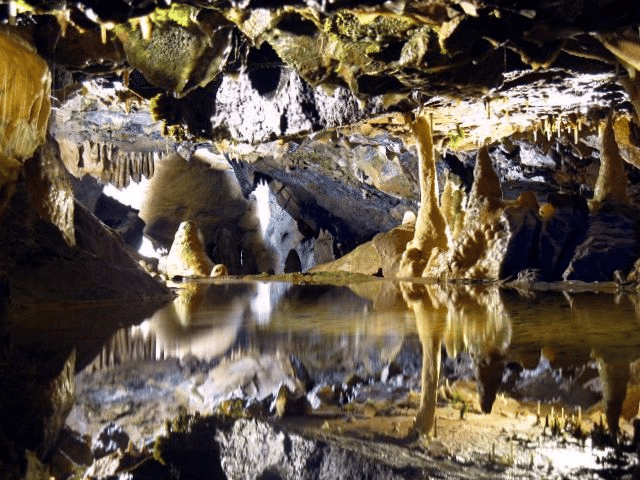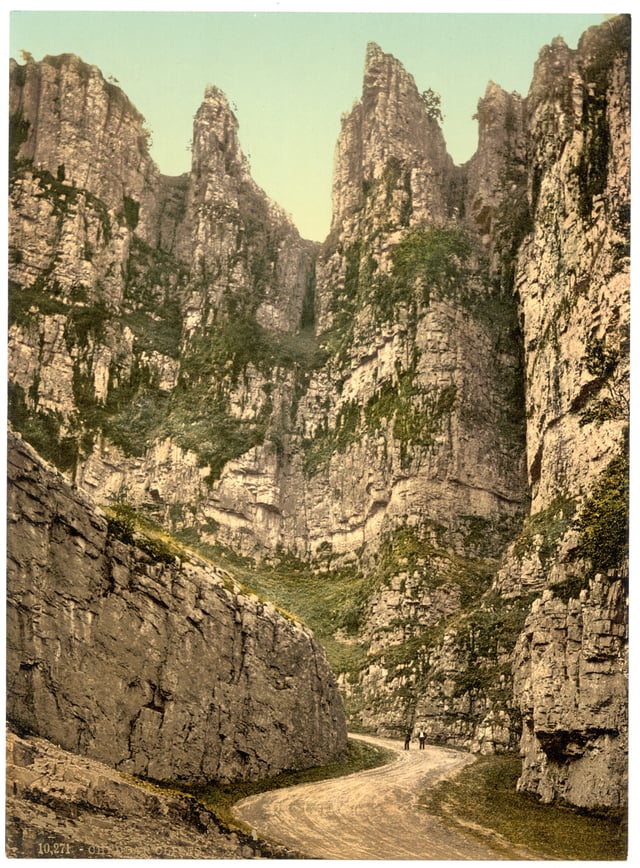Helm's Deep

Helm's Deep

| Helm's Deep | |
|---|---|
| J. R. R. Tolkien's legendarium location | |
| Information | |
| Type | fortress of Rohan fortified valley |
| Ruler | Kings of Gondor later Marshal of the West-Mark |
| Notable locations | the Glittering Caves, the Hornburg, Helm's Dike, the Deeping-coomb |
| Other name(s) | Aglarond |
| Location | the Westfold of Rohan |
| Founder | Gondor |
In J. R. R. Tolkien's high fantasy writings, Helm's Deep was a large valley in the north-western White Mountains of Middle-earth. The Battle of Helm's Deep (also called the Battle of the Hornburg), a major episode in The Lord of the Rings, is set in Helm's Deep.
| Helm's Deep | |
|---|---|
| J. R. R. Tolkien's legendarium location | |
| Information | |
| Type | fortress of Rohan fortified valley |
| Ruler | Kings of Gondor later Marshal of the West-Mark |
| Notable locations | the Glittering Caves, the Hornburg, Helm's Dike, the Deeping-coomb |
| Other name(s) | Aglarond |
| Location | the Westfold of Rohan |
| Founder | Gondor |
Middle-earth narrative
Description
The gorge, which wound deep into the White Mountains at the feet of a massive peak called the Thrihyrne, led into Aglarond, literally the Glittering Caves, also known as the Caverns of Helm's Deep, an extensive series of spectacular speleothems. In The Lord of the Rings, the caves are visited by Gimli. Gimli is a Dwarf and therefore well versed in geology; he assesses the caves to be one of the wonders of Middle-earth. He goes on to describe them at length:
- "immeasurable halls, filled with everlasting music of water that tinkles into pools, as fair asKheled-zâramin the starlight. ... when torches are kindled and men walk on the sandy floors under the echoing domes, ah! then ... gems and crystals and veins of precious ore glint in the polished walls; and the light glows through folded marbles, shell-like, translucent as the living hands of QueenGaladriel. There are columns of white and saffron and dawn-rose... fluted and twisted into dreamlike forms; they spring up from many-coloured floors to meet the glistening pendants of the roof: wings, ropes, curtains fine as frozen clouds; spears, banners, pinnacles of suspended palaces! Still lakes mirror them: a glimmering world looks up from dark pools covered with clear glass; cities such as the mind ofDurincould scarce have imagined in his sleep, stretch on through avenues and pillared courts, or into the dark recesses where no light can come..."[5]
The Deeping-stream flowed through the gorge and then down through the Deeping-coomb. This provided a supply of fresh water, particularly useful in times of siege.
The mouth of the gorge was called Helm's Gate. A large battlemented wall, the Deeping Wall, was built across the mouth; it is described as standing 20 feet (6 metres) tall, and wide enough for four men to stand abreast at the top. It was essentially solid stone, except for a small culvert which allowed the Deeping-stream to pass underneath.
At one end of the wall was a natural mountain spur, and on this spur stood a castle originally known as Aglarond (named after the caves), but later as the Hornburg (referring to the castle's great tower).
Inside the keep there were stables and an armoury, as well as a great hall in the rear which was dug out of the mountainside. There also was a great tower (the Hornburg), where the great horn of Helm Hammerhand was kept. Access to the fortress from within the Deep was made possible by a long stair which led to the Hornburg's rear gate.
A long causeway led down from the castle's main gate. About two furlongs (400 metres) down from the gate was an outer line of defence called Helm's Dike. This was a trench and rampart built right across the Deeping-coomb.
In addition to his narrative descriptions, Tolkien drew a detailed sketch of the vicinity of Helm's Deep and another of the fortifications at the mouth of the gorge itself.[6]
Helm's Deep in The Lord of the Rings
Helm's Deep appears in Appendix A of The Lord of the Rings, which states that during the winter of T.A. 2758–2759 King Helm Hammerhand of Rohan, after whom the region was subsequently named, and many of his people sought refuge from the Dunlendings under Wulf, who had overrun most of Rohan.
In The Two Towers, Helm's Deep becomes the refuge of the main army of the Rohirrim, under King Théoden, against the forces of Saruman. Although Théoden says that "the Hornburg has never fallen to assault," in the Battle of the Hornburg, a massive army of Uruk-hai and Dunlendings sent by Saruman almost overwhelms the defences. Saruman's orcs breach the Deeping Wall by setting off an explosion in a culvert. The origin of this explosion is unclear and Tolkien denotes it as "Saruman's devilry". But the defenders hold out in the fortress until dawn, when Théoden and Aragorn lead a cavalry charge that drives the Orcs from the fortress, as relieving forces assembled by Gandalf and Erkenbrand attack simultaneously, trapping Saruman's forces against a wood of Huorns dispatched by Treebeard.
External History
In Book III, ch. 5 of The Two Towers, Helm is described only as a "hero of old wars"; it seems likely that Tolkien did not envision him as a king when he wrote this chapter. The first version of the list of kings of Rohan does not appear in the manuscripts until a draft of the early chapters of Book V[7]
Tolkien had not yet envisioned Helm's Deep in his first sketch for the decisive battle between Rohan and the forces of Saruman. In an outline published in The Treason of Isengard as “The Story Foreseen from Fangorn," the Rohirrim rode west at Gandalf's urging, as in the published text, but met the army of Saruman on the open plain. An indecisive battle ensued, after which the Rohirrim camped for the night, and woke to see the enemy surrounded and destroyed by a wood that had appeared overnight.[8]
Helm's Deep is generally believed to be based on the Cheddar Gorge, a limestone gorge 400 feet deep in the Mendip Hills, in Somerset, England. Cheddar Gorge is the site of a large cave complex which Tolkien visited on his honeymoon and revisited in 1940, and which he acknowledged as the original of the Glittering Caves.[9]
Later Writings
Subsequent to the publication of The Lord of the Rings, Tolkien wrote at some length about the history of Rohan. These writings were not published during his lifetime, but were collected by Tolkien's son Christopher in Unfinished Tales[10]
According to these accounts, the fortresses of Aglarond and Angrenost (renamed Isengard by the Rohirrim) were built by Gondor to guard the shoulders of the Gap of Rohan. Like Angrenost to the north, it was initially well guarded, but as the population of Calenardhon (the later Rohan) dwindled it was not maintained and, losing importance, was left to a hereditary small guard who intermarried with Dunlendings.
When Cirion, Steward of Gondor, gave Calenardhon to the Éothéod, Aglarond was transferred into the care of the Rohirrim, who named it Súthburg ("South-fortress" in Old English). The Gondorian guard was merged with that of Angrenost to the north, which remained in the keep of Gondor. Guard duty of the Fords was initially shared between Gondor and Rohan, but later maintained only by the Rohirrim.
Sources and inspirations

Cheddar Gorge in the 1890s
Tolkien visited the caves at Cheddar Gorge in 1916 on his honeymoon and later said that they were the inspiration for the caves at Aglarond. [11]
Adaptations
The fortress was featured as a scenario board in the Lord of the Rings board game, first released in 2000.
In Peter Jackson's 2002 film The Two Towers the keep was built into the mountainside and resembles a World War I bunker, in keeping with Tolkien's history as a soldier in that war. The entrance to the glittering caves of Aglarond is also contained within the Hornburg itself, rather than at the top of the deep behind the Deeping Wall as in the book. Further, the Uruk-hai assault the main gateway in a testudo, or locked-shields style formation, and the 'blasting fire' is depicted as gunpowder.
The 2013 expansion to The Lord of the Rings Online entitled Helm's Deep depicts the fortress of Helm's Deep as well as the surrounding area of Western Rohan. The Battle of Helm's Deep features prominently in the expansion.